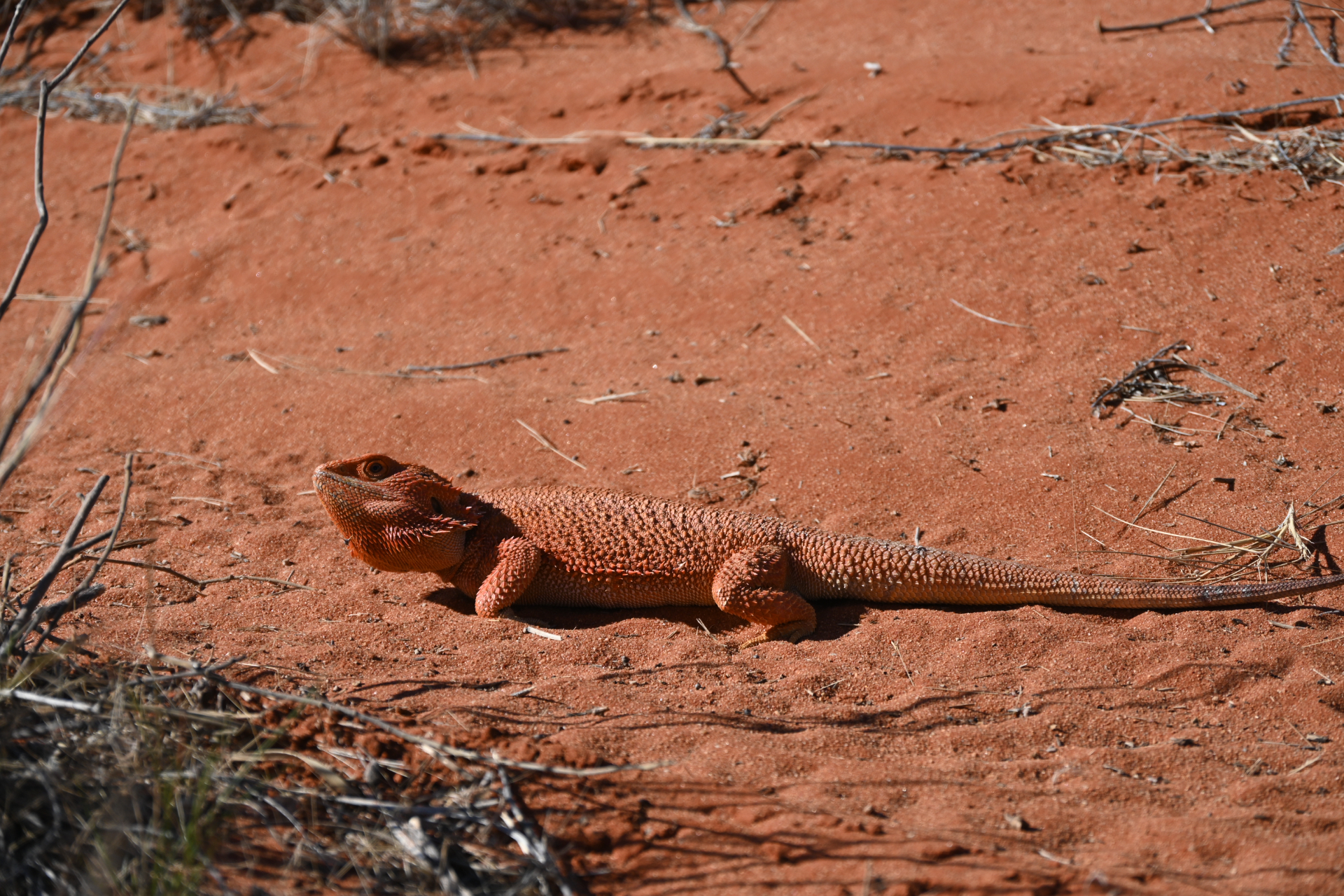
The plan
It’s simple, leave from Purni bore, and arrive at Birdsville… except its not that simple. The Simpson is a criss cross of different “lines”. You have the QAA, Rig Road, French line, K1 line, Madigan and others. Each serving a specific purpose in the past and today offering different challenges.
Your typical crossing picking a straight route across is probably around 3-4 days. This is 3-4 days without access to water, shops, or fuel. We however decided on route that touched on the French, Madigan, QAA and K1. The idea being that we wanted to see a bit of everything along with check out some of the interesting POIs like Poeppel’s corner (the corner of QLD, SA and NT).
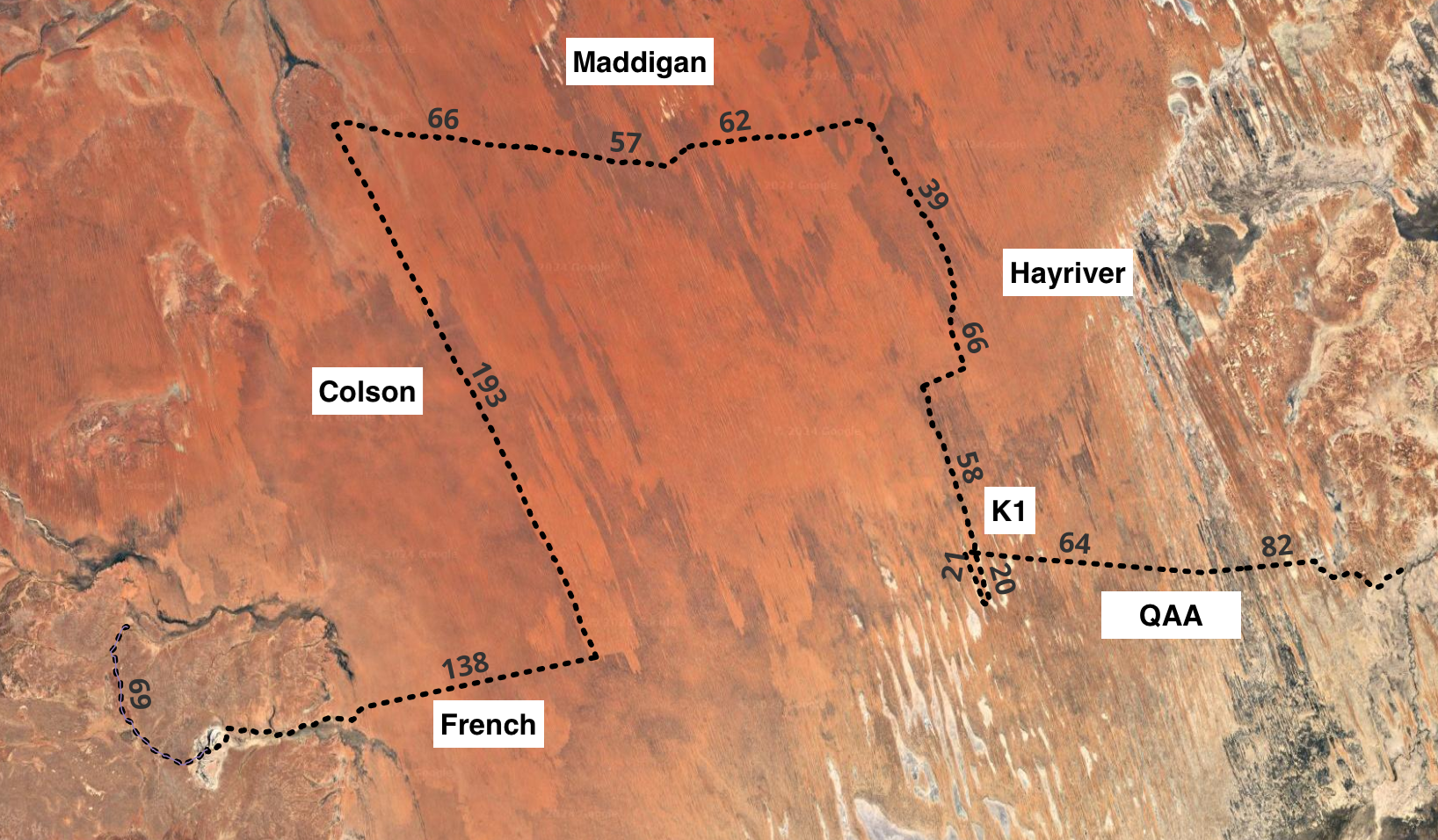
This resulted in a plan that was upwards of 12 days and 914km without services. We plan on days being low kilometers to ensure we have enough water and fuel in case something goes wrong or backtracking is required.
Adding to complications was the recent rainfall in the area. We had to keep a close eye on river levels / crossing locations and which properties we could enter and exit through.
In the end we completed the trip with 8 days in the desert. The second half of Hay River track was exceptionally good, and we breezed through the QAA line. A lot faster than the Madigan and French lines.
Permits
There’s a number of permits required when travelling the Simpson. For the Madigan line a Central Land Council entry permit is required as you are travelling through their land. Entry from SA and into Poepell’s corner requires South Australia Desert Parks pass. Camping in the QLD section requires a QLD parks camping permit.
The CLC permit can through very last minute. If we didn’t receive this we would have had to adjust our route. Luckily it was fine.
Australia is big….
Really big. Our plan was to start from Mt Dare to cross the desert, however just getting to Mt Dare from Melbourne is 23 hours of driving and 1,948km. To assist with this we decided to travel a week earlier than expected to Adelaide and start journey from there. This still left 1,237km and 15 hours driving which we split into two - stopping at William Creek over night.

On the way back we spent some time in Longreach to check out the Qantas museum and give ourselves some recovery time. Then Cunnamulla, Griffith followed by arriving at our home in Melbourne. This totalled 2,627km’s from Birdsville.

The crossing
Much like the CSR, the real challenge in these journey comes to preparation. If you nail your planning, packing and other prep work, the journey itself is uneventful and breeze. Take your time on all the dunes and don’t try to push yourself or the equipment.
We had a good idea from other peoples crossings what to expect and a good idea from our own previous journeys what works for us. We didn’t change much of our load out from the CSR which made prep super simple for us. Not much in the way of new equipment or requirements. The middle of the desert isn’t the place where you want to experiment.
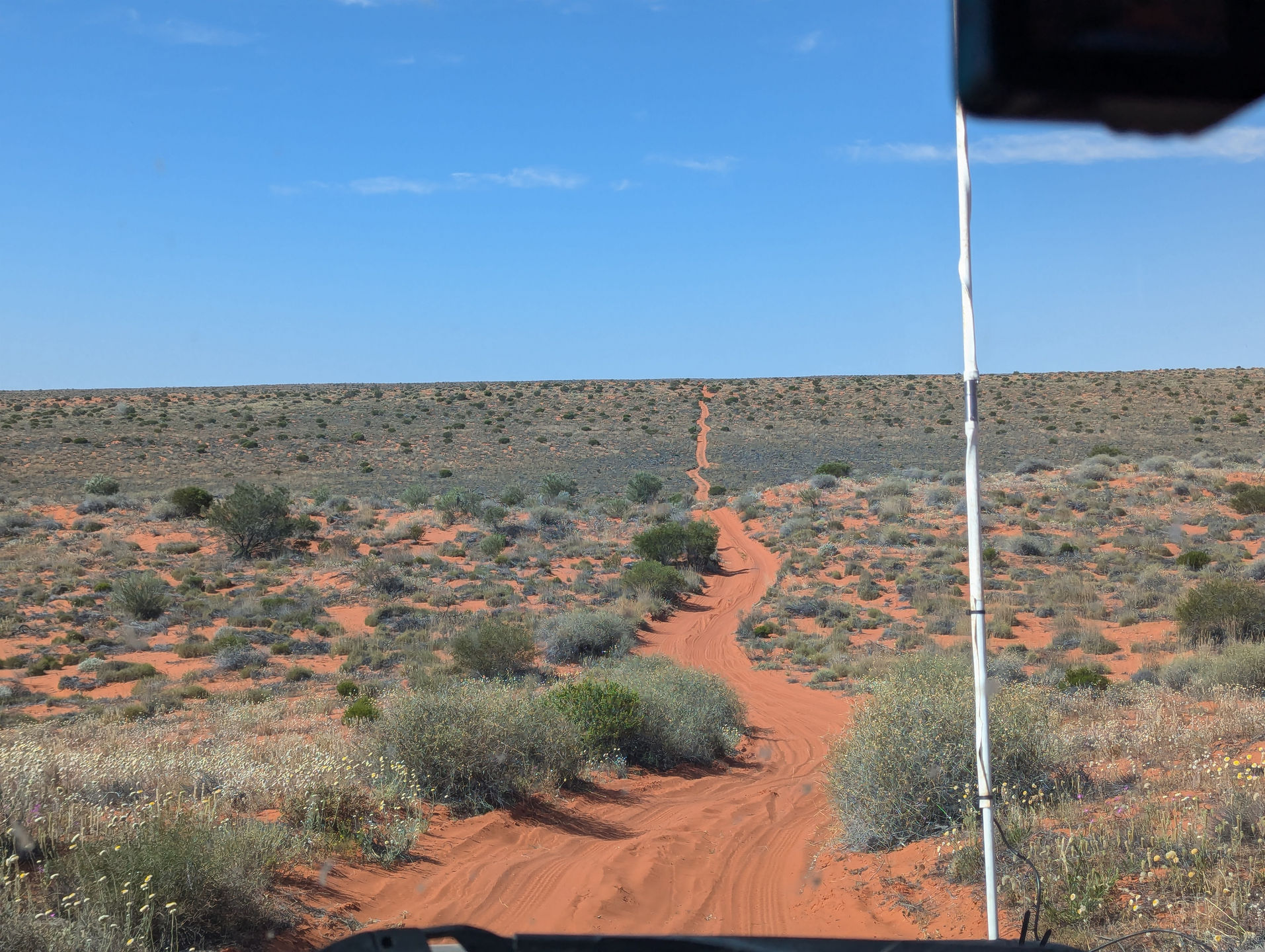
The dunes are so large and long and it’s impossible to express their size purely in a photo
I was amazed about how different the dunes were between the lines and how they changed as we progressed east. For the most part we just crawled up each dune. There were maybe 4-5 dunes (including “big red”) where we needed to use a little bit of momentum to get over - the rest we could do at very low speed. This protects our car, makes for a comfy ride and prevent further damage to the track.
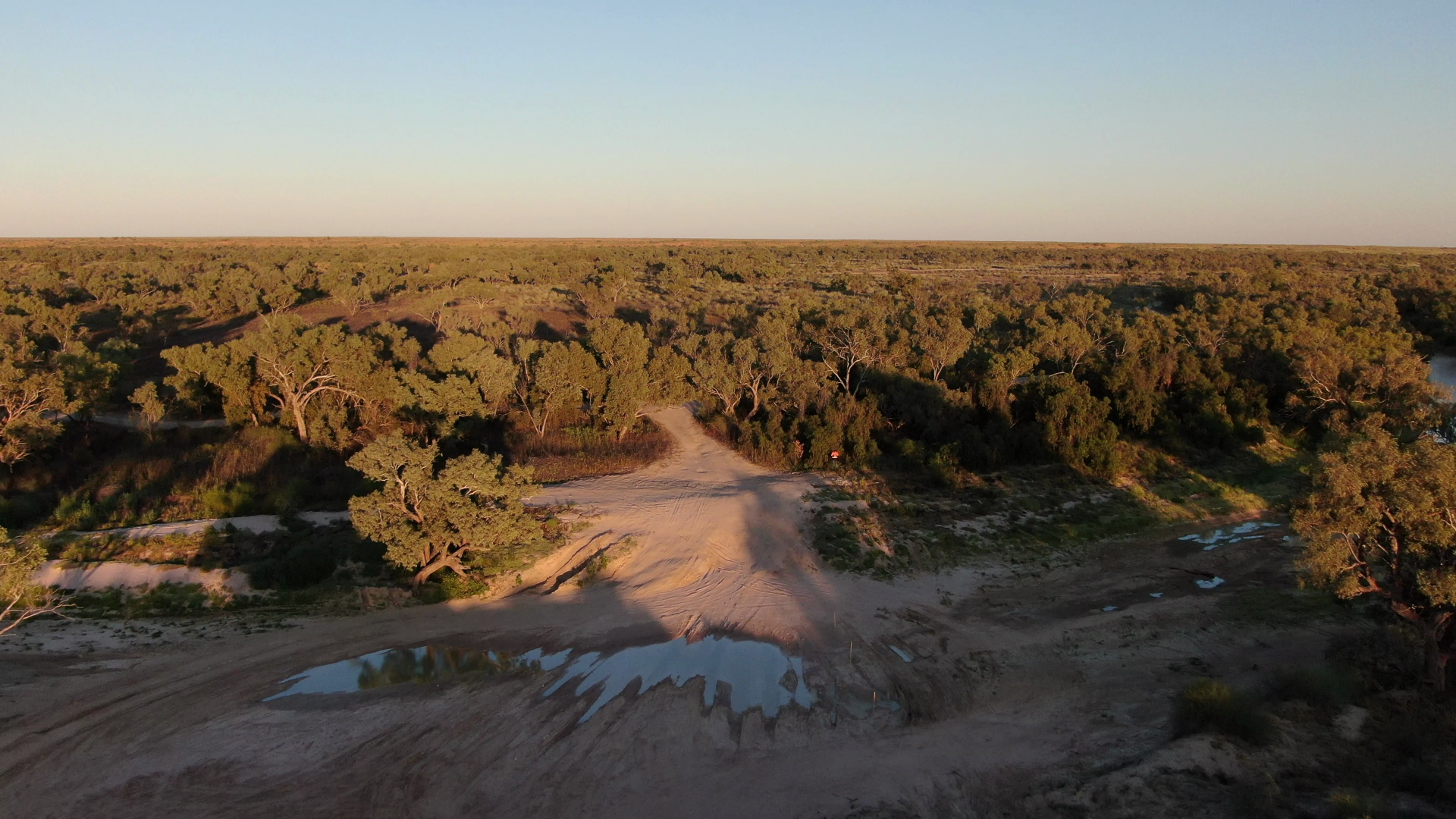
Surprisingly Eyre Creek had completely dried by the time we arrived so we didn’t require any water crossings this trip!
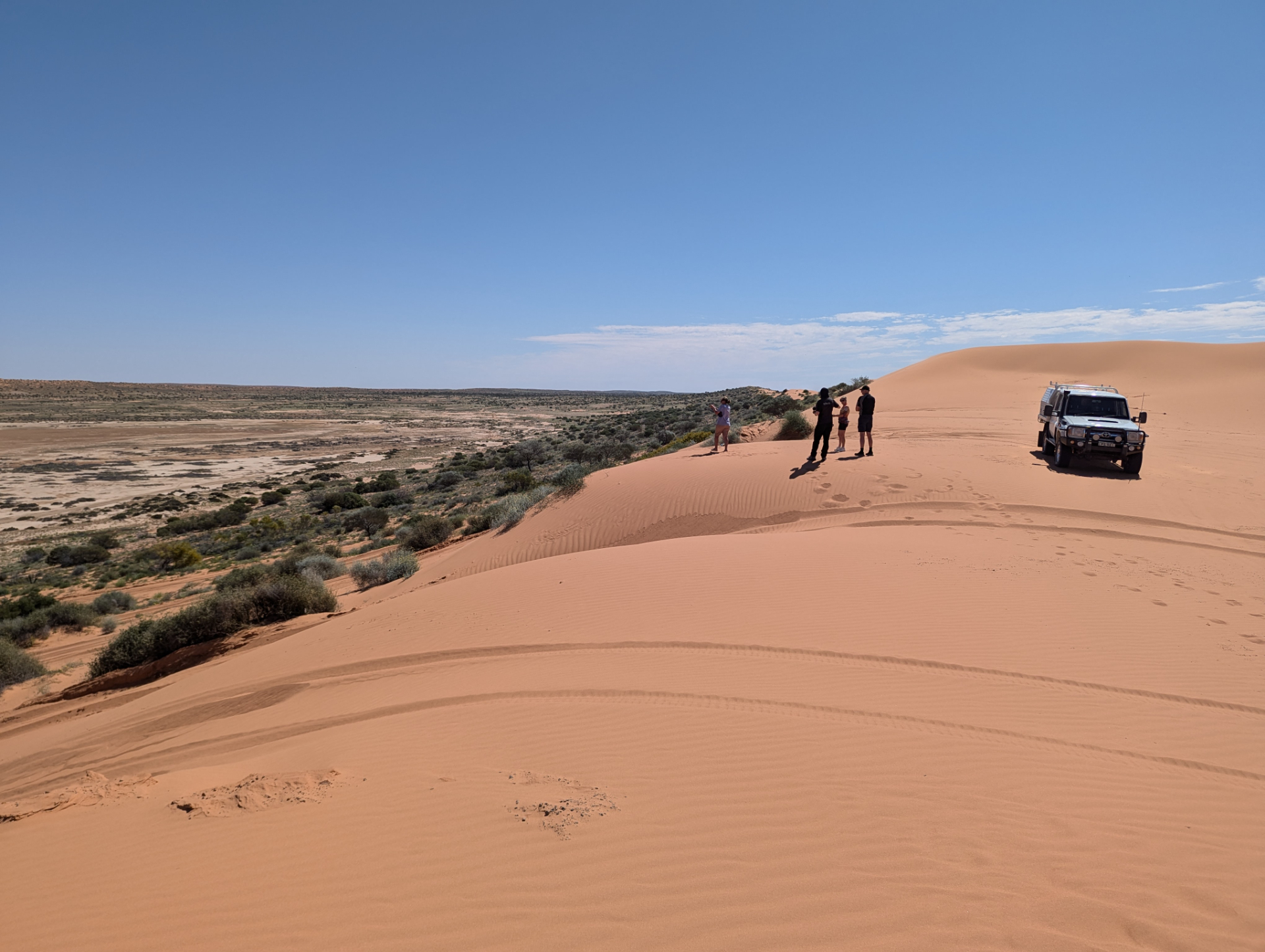
‘Big Red’ is the final dune of a typical Simpson Desert crossing. 30ish meters tall this dune is one of the hardest to cross, but technically not very challenging when approached carefully. It’s probably best to try crossing this dune like you would usually would the first time to get and understanding of the challenge before making adjustments.
You’ll soon realise that crawling over isn’t viable for ‘Big Red’. Air down. Right down. Most vehicles will be fine down to like 8 psi, so don’t be afraid to drop those tyre pressures down to 12 or even 10. The top is very soft, you won’t rock around in wombat holes at the top so once you get passed the corrugated sections just put your foot down. The top is flat so you’ll be fine at the top.
I tried a few different configurations for the car (have some fun and do some laps). I found that traction control has zapping a bit of energy at the top - turning this entirely off helped a lot with some of the harder approaches. Diff locked, 4low, gogogo.
Weather
It turns out that while we expected fairly cool evenings and mornings the desert had other ideas. Many towns around the Simpson desert broke their hottest August temperature records. Our extra blankets weren’t used and rarely did I need to wear my hoodie. The middle of the days were extremely hot, as such we used that time for mostly travel. Even lunch breaks were brief. Unlike the CSR with wells and trees - there was very little shade.
Fuel
We used the final CSR fuel consumption readings to calculate our expected fuel usage (22.8l/100km). We rounded up to the nearest jerry can - this meant full tank + 4 jerry cans. We had some extra carrying capacity so took an additional 2 jerry cans just in case. 6 in total. Four of these were stored in the vehicle and 2 on the roof.
Priority was to get the roof jerry cans off, so as soon as fuel tank had room these went inside. You want the roof rack as light as possible as the forces applied when hitting wombat holes at the top of dunes are significant. Many people crossing the Simpson have stories of roof racks breaking and to prove the point some travellers we came across had just that happen. Most of their fuel was stored on the roof rack.
Using the final CSR fuel consumption readings were pretty much spot on for the Simpson. 204 litres over roughly 950km = 21.4l/100km.
But our story about fuel doesn’t end here. It seems that the fuel we picked up back in Adelaide had some sort of contamination. The differential pressure sensor triggered on the fuel filter just past Dalhousie on the French line. We packed two fuel filters as we are well aware of the risks of filling up from jerry cans. The thing is though that the fuel filter warning had come on before we had emptied any jerry cans.
The light is only a warning, you’d typically just get it sorted as part of the next service. We tend to ignore this warning as working on the fuel system in a dusty environment in the middle of desert can be risky. We continued on without noticing much and in Birdsville replaced the filter - without clearing out the housing.
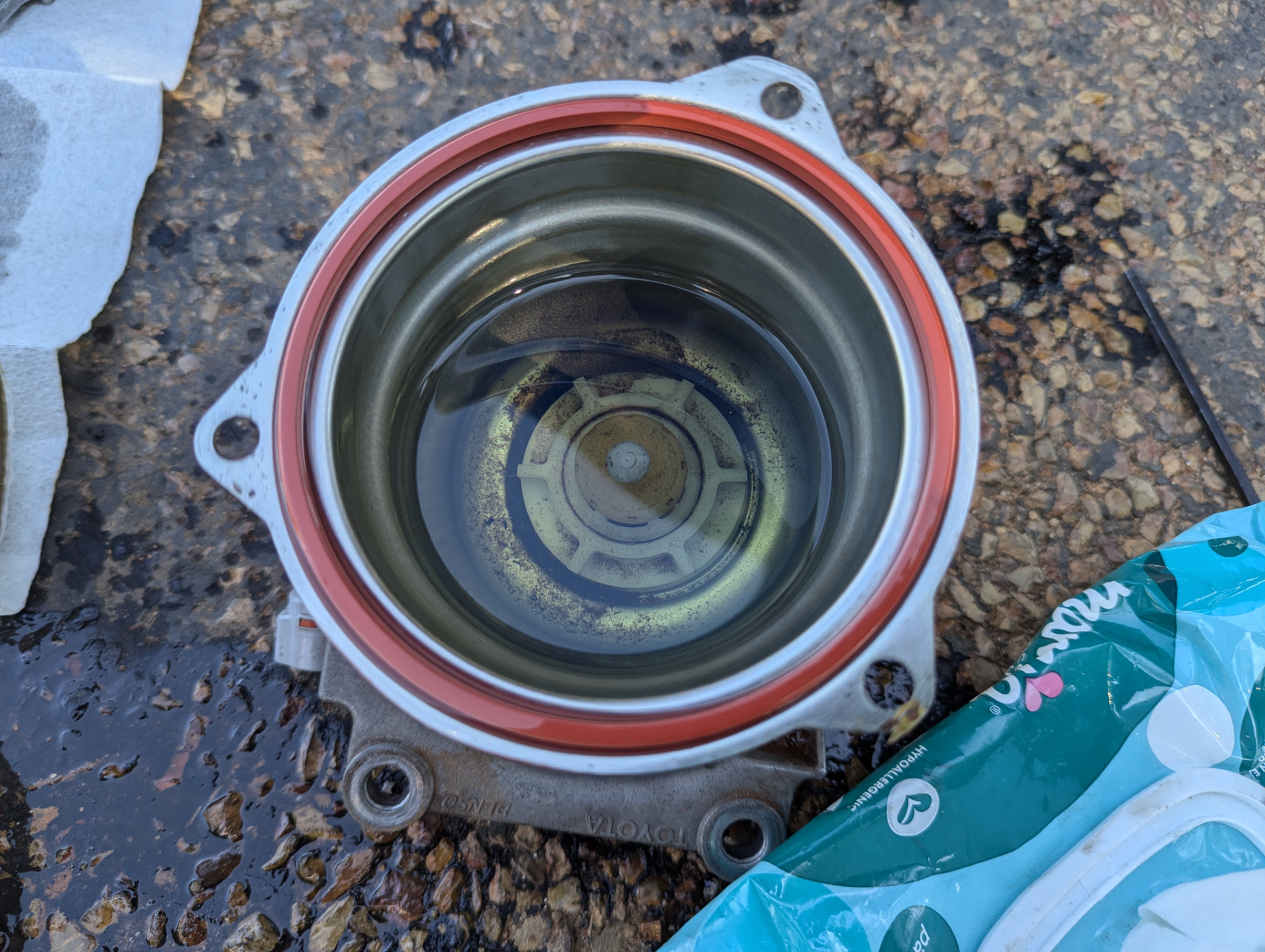
It wasn’t long however until the fuel filter warning came on again and eventually the same problem - fuel rail pressure preventing the car from accelerating quickly. We replaced the filter again. As we replaced bad fuel with good fuel the problem started occurring much further apart. At this stage we think we are mostly clear of the issue, however expect to go through a few more filters as the final crap works its way through the system.
Other faults
We had traction control fault occur several times. The timing of this aligned with when the HF APRS radio transmitted. Tightening up the sand flag antenna and adjusting the feed line seemed to resolve this mostly.
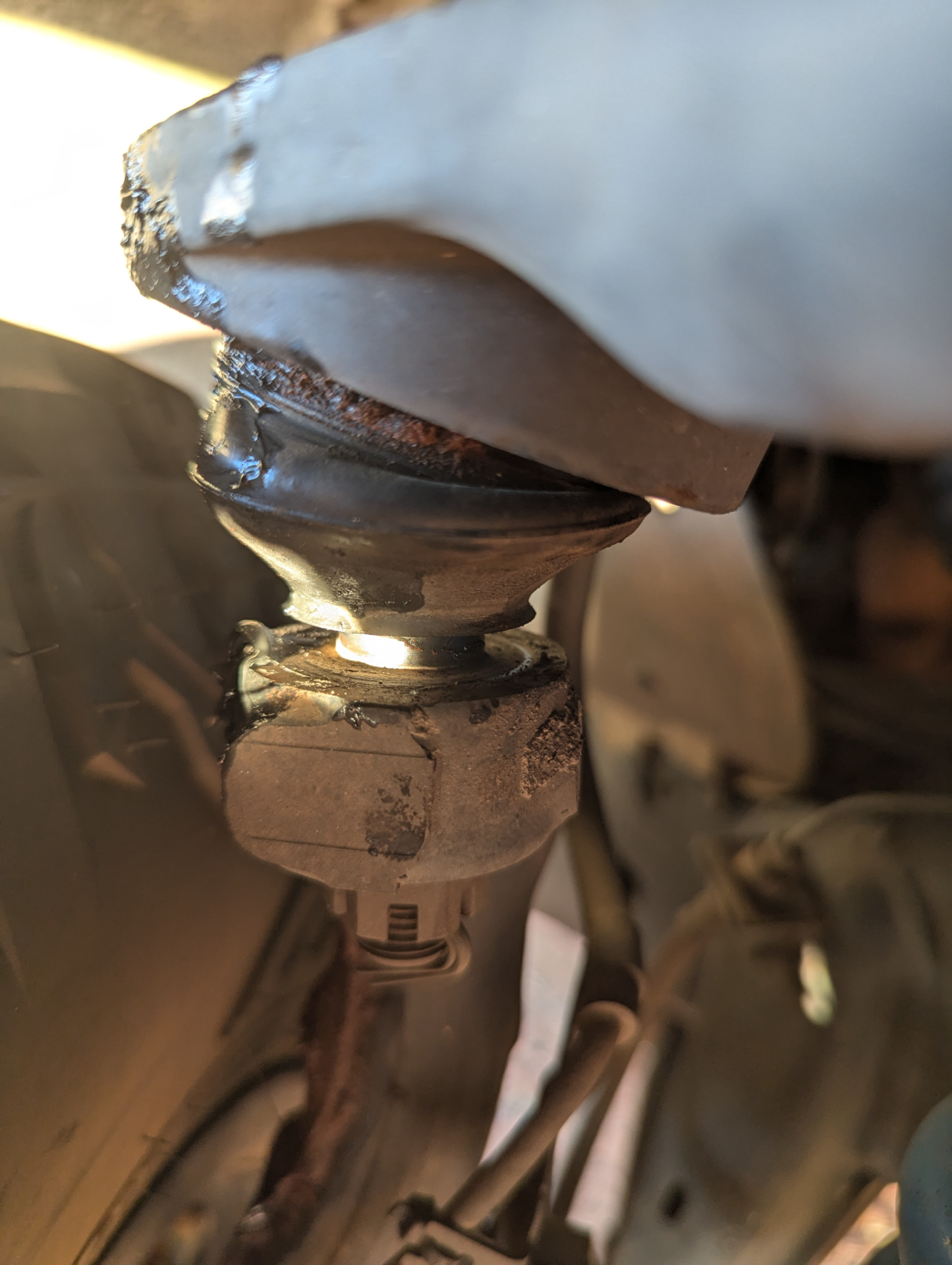
Upper control arm ball joint boots seem to be oozing grease. These might be over packed or some other issue - still needs to be investigated.
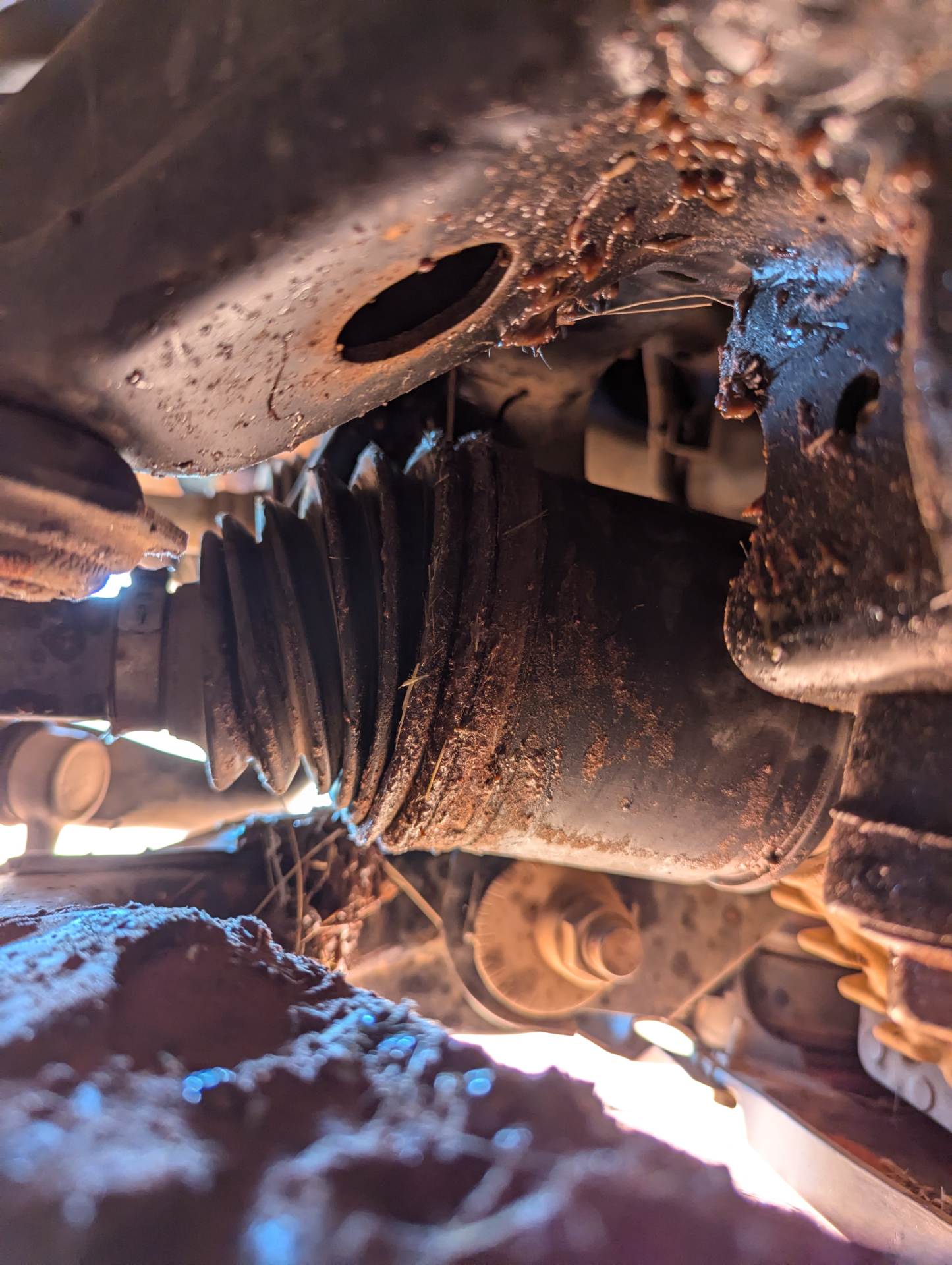
Drivers side CV boot seems to be leaking grease. This also needs to be investigated - an obvious hole or puncture couldn’t be spotted this time.
Food
Something new for us this trip is my decision to eat entirely Vegan. Geordie being extremely supportive in this decision mostly ate the same meals as myself as we don’t like to cook two different things. An amazing side effect of this is that vegan produce often can be stored warm and has long shelf lives. This left our fridge/freeze much more empty than typical allowing us to freeze some bread and have plenty of room for cold drinks. Next time I might consider packing some ice-creams.
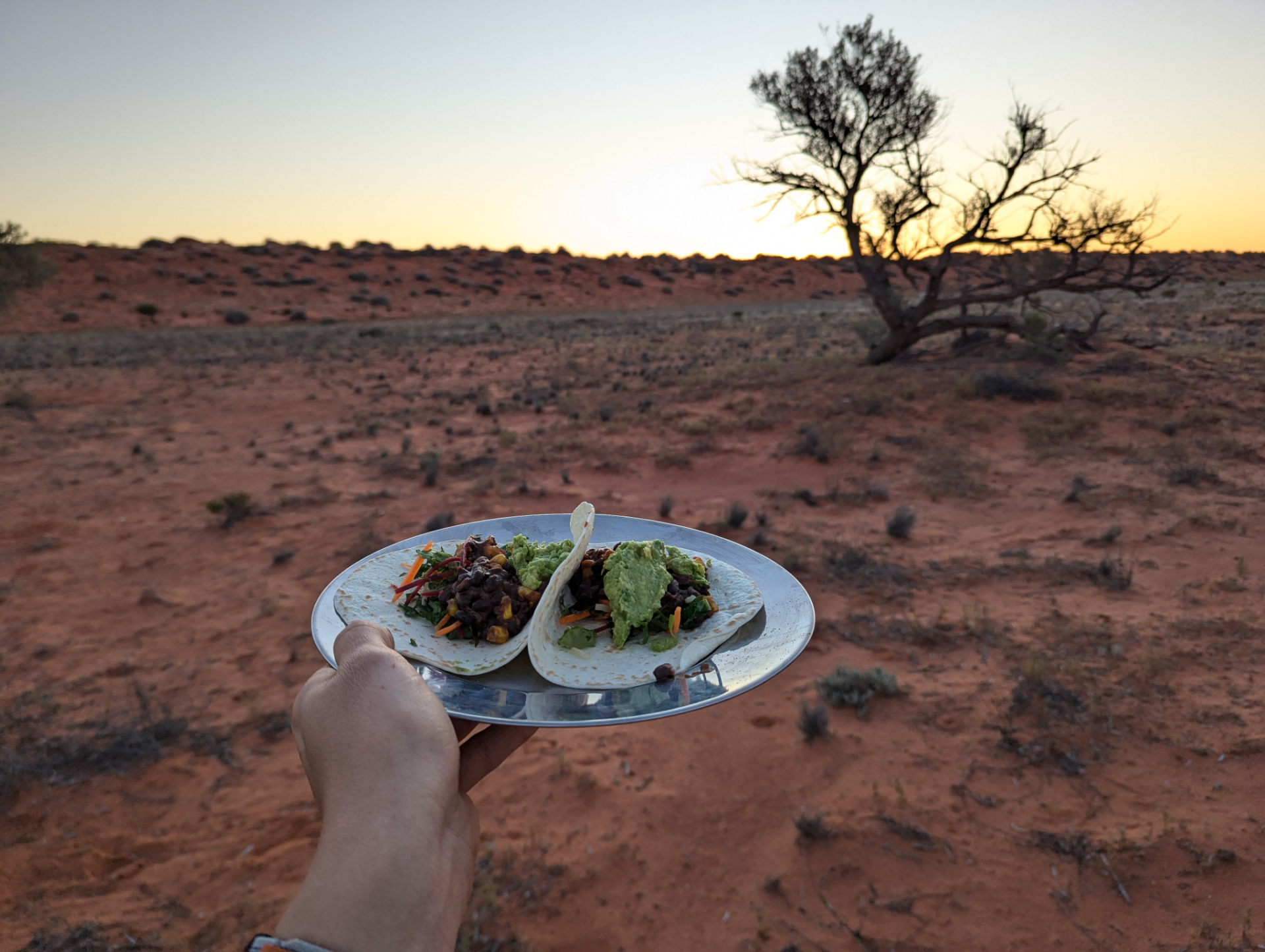
Some of the meals we had were:
- Tacos
- Nachos
- Spaghetti
- Rice
- Wraps
- Pancakes
- Bagels
- Burgers
None of these meals are vegan specific but since most of the core ingredients come in tins (veggies, beans, jackfruit, lentils) packing became a breeze.
Car to car wifi
Another interesting addition was Rusty’s Starlink. While I don’t see myself signing up to Musk’s service anytime soon I was very impressed with how well it worked. The dish was mounted flat on their roof rack and it was able to be used while moving.
Geordie came up with the idea of setting up a point to point wifi link between the two cars. This worked well when we had near line of sight (dropping past a dune or two meant that the signal would be lost but would quickly recover when the other vehicle reached the top of the dune) and provided internet throughout our journey.
An interesting side effect is that we could use ping -A to create an audible alert noise whenever we dropped out of range. A useful indicator to know if we were getting too far ahead and need to slow down.
A future experiment might be car to car messaging/warning service.
Tent rope lights
Finally one other little addition from an unlikely source. I bought some “Fishing rod lights” for another project that didn’t work out. These glow a nice green and red light and last an entire night. I placed these on the ropes on our swag which prevented tripping on them. Something I’m extremely good at doing.
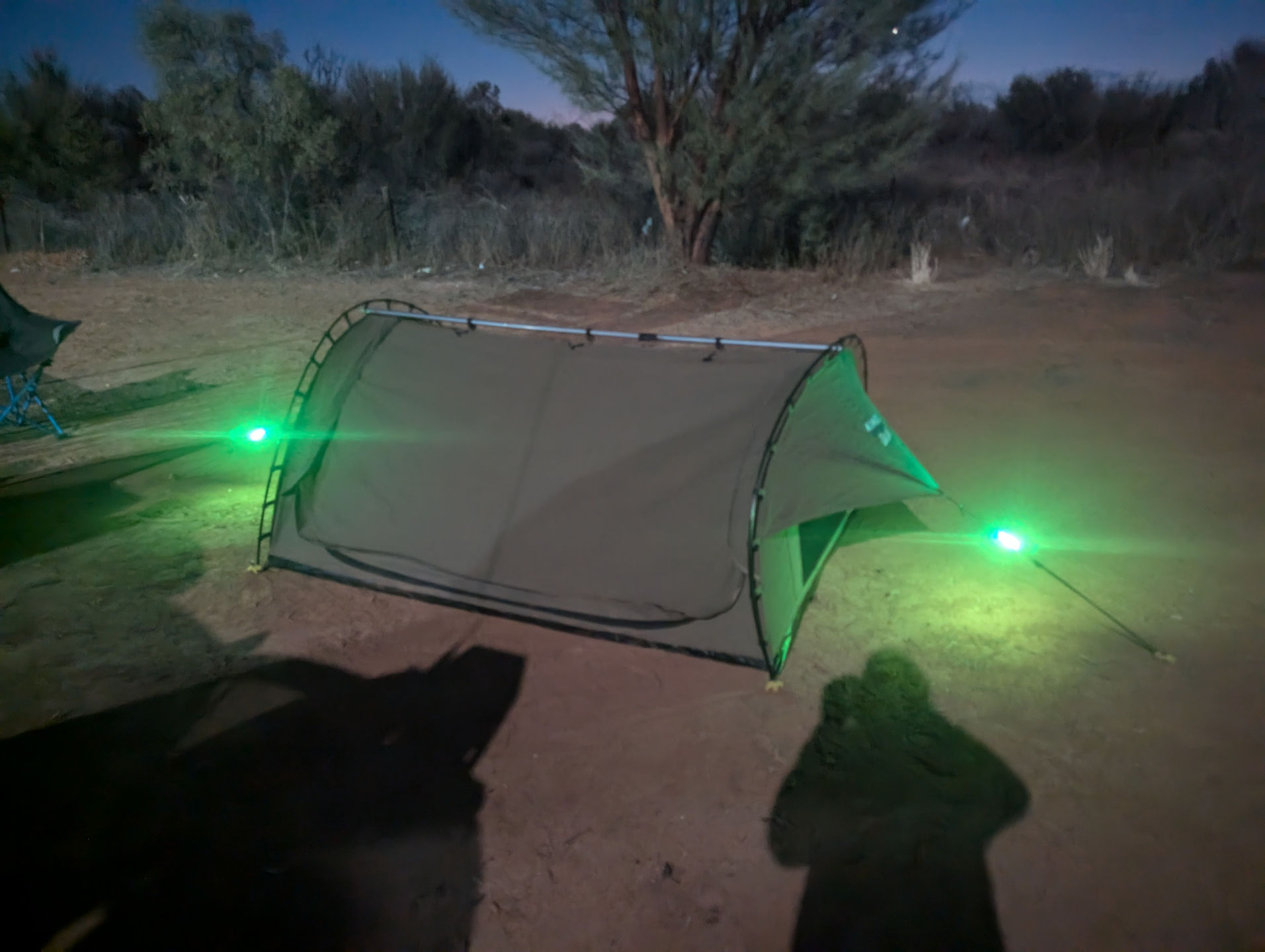
it’s not that bright in person!
Photos
That’s about it for my write up. I’m almost certain I’ve forgotten to mention a bunch of things - this adventure contained so much. If I remember anything I’ll be sure to make a follow up post here.
In the meantime if you wanted to check out some of the pictures I took of the journey I’ve uploaded them to flickr.